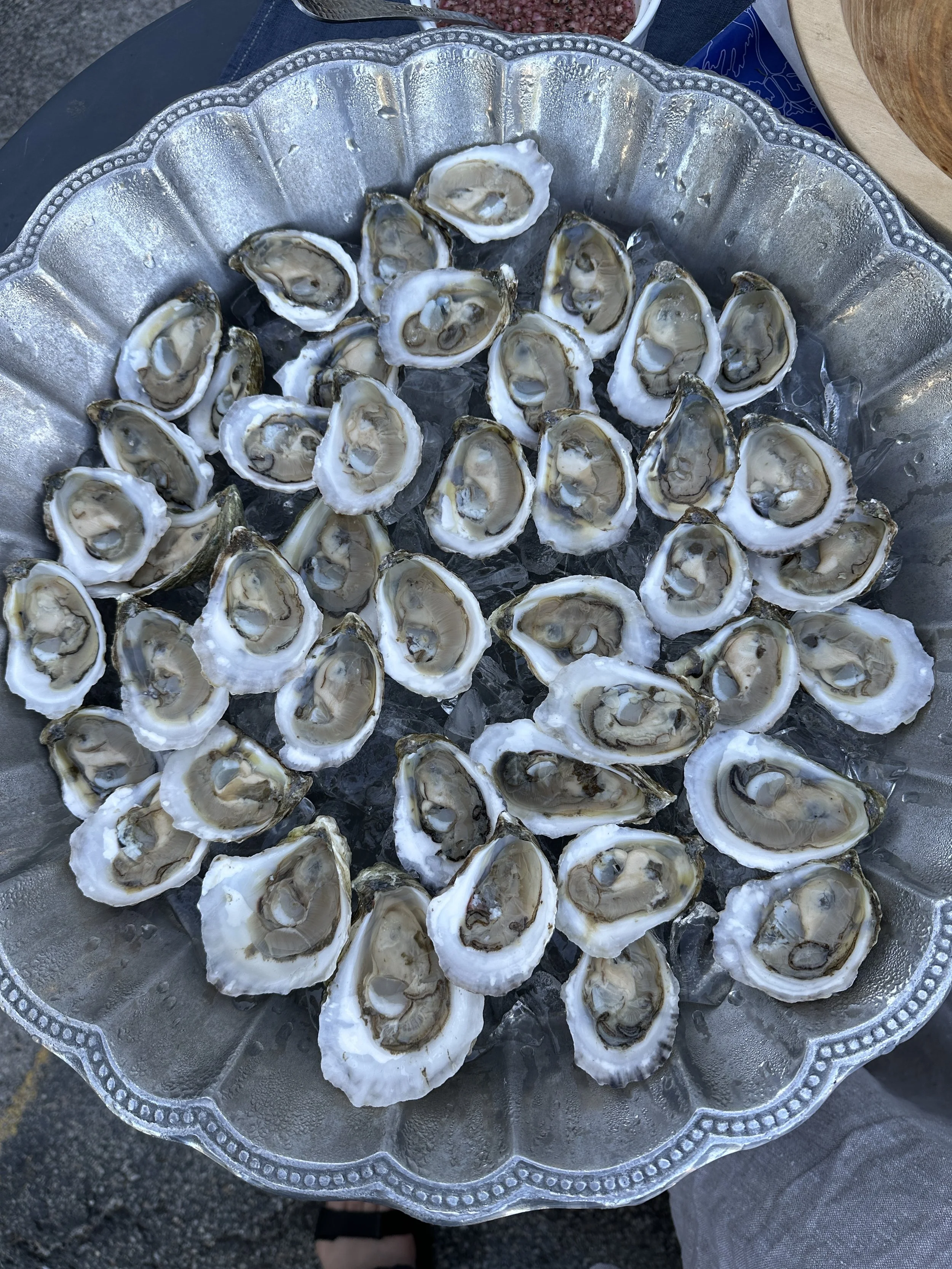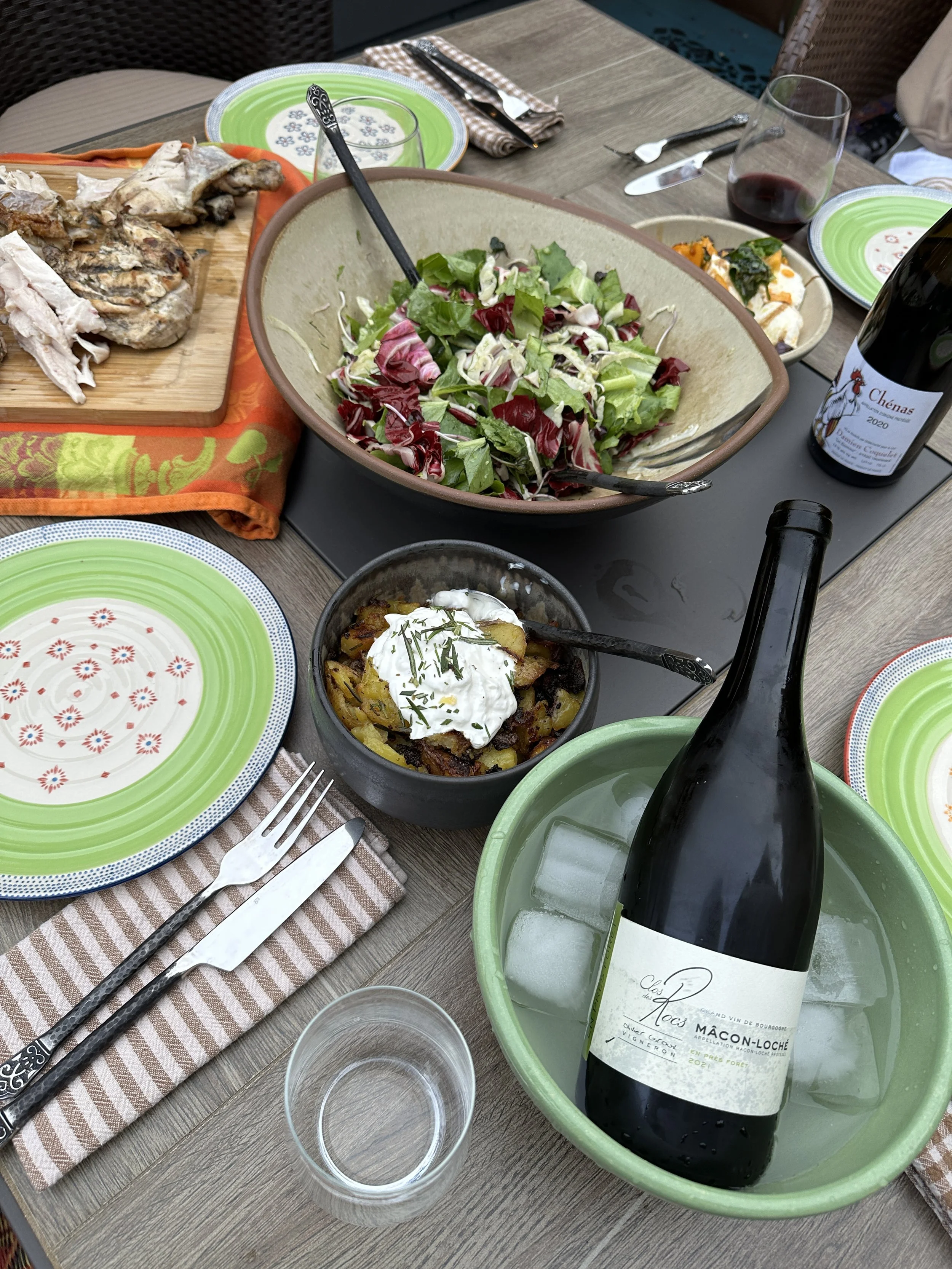Responsible Indulgence: The Shift of Season, June 2023
The color of the sky is becoming a more muted blue than a month ago, and while I claim no scientific evidence for this, I think it is a soft haze from the increasingly close sun. It is the warmth that is trying to reach out and grant our gardens and farms their potency and fertility. Is that possible? Someone smarter than me knows the answer, but regardless of the reason, it is so pretty outside. Everything is bursting open, stretching its leaves and limbs in with new growth the color of chartreuse that makes me what a pile of vegetables, simply prepared with a glass of wine that tastes of the earth. What does our earth taste of right now? It is fresh, fertile, salty, and round. It is that perfect temperature for wine, when you can go in a lot of directions depending on the time of day. In fact, that is what I want my wine to taste like right now.
If you have the Value Wines this month, consider your context before making the selection. You may find yourself on a sandy spot after a long walk, or maybe you laid out the picnic blanket on the rocks, and all you need now is a little something easy and refreshing like the 21 Gavoty Cigale Rosé. This is a wine that will come over you like warm rain and refresh your palate. It doesn’t need food, but a light, fresh goat cheese and a fruity cracker would be a delightful combination. As the evening sets in and the cooler temps require a sweater, you may want something with a bit more texture and weight. Both the 18 Clos Siguier Cahors and the 21 Pullus Halozan will deliver just that.
If you choose the Pullus, you are in for a real treat. I am guessing that this one is new to you in that it is Slovenian, but the grapes are not that far off the beaten path. It is an approachable white blend of Welschriesling, Riesling, Chardonnay, Furmint, and Pinot Blanc that is aged on the lees in stainless steel. Okay, maybe Furmint is a new one for most of us. It has wonderful weight, texture, and mouth feel. This wine has incredible, inviting aromatics both floral and fruity, it has delicious exotic fruits on the midpalate, and finishes with a savory, herbal thing that really does taste like Spring. Is your mouth watering yet? It can handle a lot of flavor, so I suggest grabbing a handful of those fresh herbs growing on your terrace, grind them with some salt and garlic in your mortar and pestle, drizzle olive oil in there and then pour it over some charred bread, fresh off the grill, perhaps rub raw garlic on that toast first!
The 21 Melea Tempranillo is a new vintage of a perennial favorite around here, and I am confident that many of you will be very happy to see that happy bee again. It is fresh and bright with great intensity and will add some spice to your pairing. Similarly, the 20 Costa al Sole Montepulciano has a beautiful ruby color and bold aromatics. It is a bit bolder and bigger than the Melea, but they share a ripeness that summer flavors invite us to bring to the table. Try either one with your next burger, pizza, or mixed grill.
Do you know that phrase, “mixed grill”? I think the first time I saw it was on a menu in Sicily, at a local tavern called Ox on the northern slope of Etna. I asked the waiter what he suggested, and he told my Dad and I to get the Grigliata Mista. There were at least 6 different types of meat on there, all simply treated before being grilled to perfection, and we tried, and delighted in every one! It is not for everyone, but try it for your next summer dinner party, and put out both of the wines listed above!
While you are cooking, you should sip on the 21 Frug Grüner Veltliner to refresh the palate. It has a soft fruit on the front, think bruised apples and exotic fruits with lots of acidity, that you don’t even notice, and then a wash of minerality on the finish. Yes, oysters; that is exactly what I would suggest. (You are getting good at this!) By the way, if you feel the impulse to dance while you are sipping, slurping, and grilling, it is to be expected. The Frug was a popular dance move in Austria in the 60’s--so go ahead and grovey with your Grüner!
The Select Wines for June speak to the increasing availability of fresh local vegetables, but in truth our spring veggies present a bit of a challenge. They need bright intense fruit with a good backbone of acid. To begin with, I chose whites that have both intensity of flavor and bright acidity to match up to that of asparagus, radishes, spring peas, and the like. The 21 Azimut White from Penedes, Spain, where the grapes grown at 250 meters (about 820.21 ft) above the sea on a southern slope that experiences a balance of intense sun and Mediterranean breezes. You will taste those two extremes in its ripeness and its minerality. It is a blend of Macabeo, Xarello, Grenache Blanc, and Muscatell. It reminds me of the honeysuckle that is just blooming in my garden, so aromatic, fresh, and fertile. The ripe peaches and lime blossom combination makes me want to make fish tacos with lots of radish slaw!
If it is something a bit more subtle that you seek, grab the 21 San Pietro Gavi. It has a delicate straw color with a hint of green, invoking the grass stains I always get on my white pants (a reminder to stick to black clothing!). The intense aromatics on this one will capture you, white flowers and soft stone fruit, both of which translate onto the palate, matched by the acidity and minerality on the finish. This one wants pasta tossed in butter and spring shelling peas, shave some Parmigiano Reggiano on there, and call it a day!
The rosé for June is one from last year’s vintage, and I have done that with intention to show you how a good quality rosé can develop with just one year in the bottle. I am not suggesting that you start to lay them all down for years to come, but one or even two years in the bottle allow for some of the complexity to really shine. (Indeed, there are some rosé built for longer aging—you will get o eof those this summer, too!) That said, 21 Domaine Gavoty Recital is a good example of a complex rosé that improves after a year. The fruit and acidity have intermingled, and the complex flavors are showing themselves. It is equal parts Grenache and Syrah with 10% Carignan, produced by direct press method with a gentle pressing of all hand harvested organic fruit. It is pale in color, but by no means a simple wine. In fact, it is captivating and beguiling with fresh berries, salt air, blood orange dredged in sea salt, and apple blossoms. Maybe it was the peonies blooming in my garden, but I felt dizzy with excitement for the aromatics and flavors of this one. I enjoyed it with fresh goat cheeses and thinly sliced prosciutto.
For the reds this month, all three offer the brightness and intensity of medium body. These reds are ideally suited for the flavors of spring. The 21 Vera de Estenas Bobal is crafted from old vine Bobal grown on clay-calcareous soils. It is fermented in cement, so no oak on this one, but the vessel still allows for air and a nice slow malolactic fermentation, so loads of texture but still maintaining freshness. There are both black and blue fruits on this one with even some hints of red berries, spice and minerality. All with a bright acidity, which makes it ideally suited for red meats, but I want to make paella for this one. I love the dish and the wine calls for its richness and intensity of flavor.
The 19 Nittnaus Blauer Zweigelt and the 21 Gaspard Cab Franc both offer wines that are surprisingly light on the palate. Surprising because after intense aromatics and dark ruby color in the glass, the wine dances on the palate with finesse and elegance. That said the wines are otherwise quite unique from one another. The Zweigelt, which I would liken to a Gamay or Pinot Noir, with just a bit more earthiness, has fresh, ripe berries that will compel you, followed by a soft earthen quality with an elegant, supple texture. The fruits are red and blue berry, tart cherry, with licorice and cocoa, and just a hint of black pepper. The tannins are relatively low. This might be the most differentiating aspect of the two wines, as the tannins on the Gaspard are much grippier. Not surprising on a Cab Franc from the Loire, but that is the only thing about this wine that reveals its origins and varietal. It is much lighter and fresher than one expects of the grape that so often feels as if it could remove the enamel from your teeth. I love the Gaspard for its surprising easy approachable quality! Both wines would pair well with ramen, and can handle soy, so get some dim sum!
For my Collectors, I looked to Italy for your picks this month and more specifically to the north. The 21 Ermes Pavese Blanc de Morgex is grown in the highest vineyard site in Europe by Ermes Pavese. Ermes is a young grower and wine maker in the commune of La Ruine in the high Alps, just moments from Mont Blanc in the Valle D’Aosta. It is there that he cultivates two hectares of a native grape known as Prié Blanc. They are grown 1200 meters (about 3937.01 ft) above the sea. Because of this extreme altitude, the vines are of original root stock—no phylloxera up here! There is a purity about the story of the wine, but also the experience of the wine is pure and quite unique. It is austere at first, quietly arriving to your nose with subtle citrus, lemon blossom, and mountain herbs, developing slowly into aromatics and flavors of wet stone, clay, herbs, and salinity, along with some stone fruits. With all the complexity, it remains refreshingly thirst-quenching. For this one, I will load up a big wooden salad bowl with all the fresh vegetables from the farmer’s market, chop some roasted almonds to sprinkle on top, and whisk up a quick Dijon vinaigrette, shave a little Manchego over the top and dive in!
The 16 Monsecco Gattinara "Osso," is an exceptional wine, full stop, but of course, I will say more than that. First and foremost, the wine comes from a lesser-known region of the Piedmont that produces remarkable Nebbiolo for a fraction of the cost of the more well-known neighboring regions. Gattinara sits west of the Sesia River with soils that are red porphyry, resulting from the former ancient volcano, which give Gattinara’s their distinctive flavor. The Nebbiolo’s of this region have all of the gorgeous and intense red fruits—cherry and raspberries—it also has the distinctive anise notes, but Gattinara’s soils give the wine a laser sharp minerality that sets it apart. This is a wine for food, so braise some short rib, or make an osso bucco, if time allows, but give it fat and it will reward you. This one could lay down for a while, but it is showing nicely right now.
I hope you enjoy your fresh vegetables, the smell of freshly cut grass, and the muted blue of our s sky.
Cheers, Maria
The Wine Lady
Follow me @ PressedForThought and read more of my thoughts on wine, food, travel, and life at PressedForThought.com




